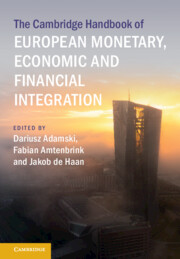Book contents
- The Cambridge Handbook of European Monetary, Economic and Financial Integration
- The Cambridge Handbook of European Monetary, Economic and Financial Integration
- Copyright page
- Contents
- Contributors
- Introduction
- Part I The Economic and Monetary Union
- Part II The Monetary Dimension
- Part III The Economic and Fiscal Dimensions
- Part IV Financial Integration
- 23 Banking Regulation in Europe
- 24 The Politics behind the Creation of the Banking Union
- 25 Failing Banks within the Banking Union at the Crossroads
- 26 The Banking Union
- 27 The Re-emergence of Market-Based Finance?
- 28 The European Strategy on Digital Finance and Its Interplay with Capital Markets Integration in the EU
- 29 Regulating Crypto and Cyberware in the EU
- Index
- References
25 - Failing Banks within the Banking Union at the Crossroads
A Great Step Forward, with Many Loose Ends
from Part IV - Financial Integration
Published online by Cambridge University Press: 28 September 2023
- The Cambridge Handbook of European Monetary, Economic and Financial Integration
- The Cambridge Handbook of European Monetary, Economic and Financial Integration
- Copyright page
- Contents
- Contributors
- Introduction
- Part I The Economic and Monetary Union
- Part II The Monetary Dimension
- Part III The Economic and Fiscal Dimensions
- Part IV Financial Integration
- 23 Banking Regulation in Europe
- 24 The Politics behind the Creation of the Banking Union
- 25 Failing Banks within the Banking Union at the Crossroads
- 26 The Banking Union
- 27 The Re-emergence of Market-Based Finance?
- 28 The European Strategy on Digital Finance and Its Interplay with Capital Markets Integration in the EU
- 29 Regulating Crypto and Cyberware in the EU
- Index
- References
Summary
The creation of the Single Resolution Mechanism has dramatically changed the approach to dealing with failing large banks in eurozone countries. Within this new framework, the Single Resolution Board has assumed core decision-making powers with regard to (a) certain preventive measures, (b) the assessment of resolvability with corresponding powers to require banks to adopt changes with regard to, inter alia, funding arrangements, business activities, or even corporate structures, and (c) the initiation and calibration of resolution tools in relation to actual resolution cases. Significantly, as part of its preventive powers, the SRB is also responsible for the development of institution-specific ‘minimum requirements on own funds and eligible liabilities’, which seek to ensure that each institution holds a sufficient base of capital instruments and other instruments eligible for the allocation of losses to investors. Moreover, a Single Resolution Fund has been established, which is funded through mandatory contributions by credit institutions and designed to satisfy a broad range of funding needs in relation to resolution actions. Against that backdrop, this chapter critically assesses what has been accomplished so far in institutional, procedural, and substantive terms, and identifies major areas of concern for further reforms.
- Type
- Chapter
- Information
- Publisher: Cambridge University PressPrint publication year: 2023



